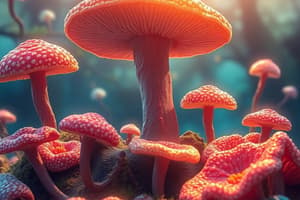Podcast
Questions and Answers
Which of the following statements about antifungal therapies is correct?
Which of the following statements about antifungal therapies is correct?
- Amphoterecin B is the least toxic antifungal agent.
- Antifungal drugs cannot harm human tissues because fungi are prokaryotes.
- Fungi can resist the oxidative damage of T cells during cell-mediated immune responses. (correct)
- Mycoses are among the easiest diseases to heal.
Which of the following statements about the categories of fungal agents is true?
Which of the following statements about the categories of fungal agents is true?
- True pathogens exhibit dimorphism based on temperature differences. (correct)
- True pathogens are not endemic to certain regions.
- True pathogens lack the ability to produce enzymes and proteins.
- All fungi are considered true pathogens.
Which of the following statements about controlling mycotic infections is false?
Which of the following statements about controlling mycotic infections is false?
- Prevention involves reducing contact with spores through protective clothing.
- Immunization is usually effective. (correct)
- Prevention involves reducing contact with spores through the use of masks.
- Surgical removal of damaged tissues may be necessary in some cases.
What is a common side effect of antifungal treatment, especially with long-term use?
What is a common side effect of antifungal treatment, especially with long-term use?
Which of the following statements about fungal diseases is true?
Which of the following statements about fungal diseases is true?
Which of the following is NOT a category of clinical manifestation of fungal disease mentioned in the text?
Which of the following is NOT a category of clinical manifestation of fungal disease mentioned in the text?
What is the distinction between true fungal pathogens and opportunistic pathogens?
What is the distinction between true fungal pathogens and opportunistic pathogens?
Which of the following is an example of a toxicosis mentioned in the text?
Which of the following is an example of a toxicosis mentioned in the text?
What is a common target for antifungal treatment?
What is a common target for antifungal treatment?
Which of the following statements about antifungal therapies is true?
Which of the following statements about antifungal therapies is true?
Which of the following is considered the 'gold standard' of antifungal agents?
Which of the following is considered the 'gold standard' of antifungal agents?
Which of the following is NOT a category of asexual spores produced by fungi?
Which of the following is NOT a category of asexual spores produced by fungi?
Which of the following fungal infections is caused by inhalation of spores from soil or decaying vegetation?
Which of the following fungal infections is caused by inhalation of spores from soil or decaying vegetation?
Which of the following conditions is caused by an allergic reaction to fungal spores?
Which of the following conditions is caused by an allergic reaction to fungal spores?
What is the primary mechanism of action for azole antifungal drugs?
What is the primary mechanism of action for azole antifungal drugs?
Which of the following fungi is a common cause of toxicosis in livestock and humans due to the production of mycotoxins?
Which of the following fungi is a common cause of toxicosis in livestock and humans due to the production of mycotoxins?
Flashcards are hidden until you start studying




